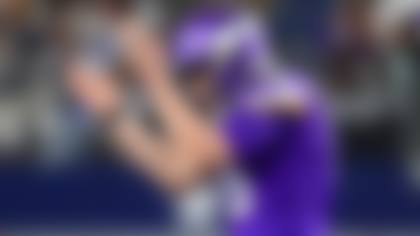There's no shortage of Super Bowl LIV storylines ...
Can Andy Reid earn his first ring in his 29th playoff game as a head coach ... or will Kyle Shanahan hoist the Lombardi Trophy in his first postseason in the big chair? How about the fact that 49ers veterans Richard Sherman and Emmanuel Sanders each have as many Super Bowl appearances themselves as the entire Chiefs roster combined? And then there's arguably the two best tight ends in the game today -- San Francisco's George Kittle and Kansas City's Travis Kelce -- squaring off on football's biggest stage.
I could go on and on. This game has so many angles to cover, so many matchups to explore. But they're all dancing around the one basic question everyone wants to know: What's going to happen at Hard Rock Stadium on Feb. 2? My historical reference model relies on data from 15 previous seasons to create a framework for predicting just that.
Below are 10 numbers to arm you with the predictive contextualized information that is most likely to determine who will win the Lombardi Trophy ... and who'll just be picking 31st in the 2020 NFL Draft in Las Vegas. These figures flag as the most important factors when it comes to forecasting each team's ability to earn (or prevent) first downs and touchdowns.
81.8
The 49ers have rushed the ball on 81.8 percent of first-down snaps in their two postseason wins. These 22.5 first-down rushes per game have averaged 4.87 yards, with four rushes of 10-plus yards. The Chiefs have only rushed the ball on 43.8 percent of first-down snaps in their past two games, but they've averaged 5.5 yards per rush and accumulated six rushes of 10-plus yards. Over the course of the regular season and postseason, both defenses have yielded 4.72 yards per rush on first down, and in the past two playoff games, each has allowed more than 72 percent of passes to be completed on first down (72.4 for the Chiefs, 79.3 for the Niners). The takeaway: First-down play-calling will be a big factor in setting the tone and rhythm of the game.
16
Since the start of last season, 16 of Patrick Mahomes' 17 interceptions have come when the defense rushes four or fewer players. Next Gen Stats shows that dropping seven or more into coverage is a strategy that Niners defensive coordinator Robert Saleh should employ, especially considering that when Dee Ford has been on the field, San Francisco has been able to get pressure on opposing passers on 33.5 percent of dropbacks, a figure that would top the league if Ford had played enough snaps.
15.8
Speaking of Ford being on the field ... According to Next Gen Stats, the 49ers have sacked opposing quarterbacks on 15.8 percent of dropbacks with No. 55 in pursuit, as opposed to just 5.7 percent when he has not been on the field. Looking at San Francisco's ability to disrupt (i.e., get within a 5-foot halo of a quarterback in his field of vision, as measured by computer vision), the Niners' front is similarly impacted by Ford's presence: San Francisco disrupts at a rate of 34 percent with Ford, as opposed to 20.8 percent without.
10
Mahomes has scrambled 10 times in the past two playoff games. According to Pro Football Focus, he's turned those scrambles into seven first downs and 112 rushing yards, including that incredible 27-yard touchdown scamper against the Titans in the AFC Championship Game. The QB's efficient scrambling is yet another strategic reason for not sending more than four pass rushers. San Francisco linebackers Fred Warner and Kwon Alexander, who both do an effective job of stymying opposing rushing attacks with their sideline-to-sideline speed, will have to be especially mindful of the reigning league MVP's legs.
20.3
No quarterback this season has a higher yards per attempt on deep passes (20-plus air yards) than Jimmy Garoppolo's 20.3. His 58.1 completion percentage on such passes also paces the NFL. Part of the reason for this? In Kyle Shanahan's prolific scheme, per NGS, receivers have averaged a league-best 2.9 yards of separation on deep passes. Another element of efficiency? Emmanuel Sanders' precise route-running has drawn defenders away from other pass catchers, earning him the eighth-highest off-ball win share among receivers, per my win share model. Here's the thing, though: Garoppolo only throws deep balls on 6.2 percent of his passing attempts -- the lowest figure among qualified quarterbacks. So Jimmy G and the Niners pick their spots on when to go downfield.
5.6
When George Kittle is on the field, the Niners average 5.6 yards per rush on outside-the-tackles runs, per NGS. When Kittle is off the field, outside-the-tackles rushing gains drop to 3.3 yards per rush. Kittle also has forced the most missed tackles among tight ends (20, per PFF), with Travis Kelce ranking second (18).
929
Richard Sherman has lined up on the left side of the defense on 929 snaps this season, according to Next Gen Stats. That accounts for 97.8 percent of his 950 total snaps, meaning he's only lined up on the defensive right for 21 snaps. Early in the NFC Championship Game against the Packers, Sherman lined up on the defensive right for a few snaps. It's hard to assess if that was a strategy that San Francisco would have used more if the game had stayed closer. (Maybe Saleh and Co. didn't want to show their hand.) However, it's extremely likely that Andy Reid's ability to scheme pass catchers open will be a much bigger element of this game than it was in the NFC title bout. Reid's ability to find mismatches and utilize the speed of his skill players, especially chess pieces Tyreek Hill and Travis Kelce, could factor into Sherman's positioning.
10.1
When Mahomes has 2.5 or more seconds to throw, he averages 10.1 yards per attempt -- that figure leads the NFL, per NGS. If Mahomes' protection holds, or he's able to extend the play (or both), this could be a problem for a defense that only allowed 34 receptions of 20-plus yards (fewest in NFL) and 113 of 10-plus yards (fewest by 12).
13
While shutting down deep passes is a source of strength for the Niners' defense, completing deep passes is where the Chiefs' offense thrives. Despite missing two games due to injury, Mahomes leads the NFL with 13 deep touchdown passes this season. The Chiefs have the most receptions of 30-plus (34) and 40-plus yards (20) this season. Not only have these passes kept the chains moving fast for Kansas City, but the Chiefs have scored 24 touchdowns of at least 20 yards.
12.3
Injuries have limited Joe Staley to nine games this season, and Jimmy Garoppolo has certainly been more comfortable with his blind-side protector in tow. With Staley on the field, Garoppolo has been disrupted (reminder: this means defenders enter the 5-foot halo around the quarterback, in his field of vision) on 22.1 percent of dropbacks. Without him? That number jumps 12.3 percentage points to 34.4. In the build-up to this game, a lot of focus has been placed on the Niners' defense, and deservedly so. But don't overlook the impact of Steve Spagnuolo's K.C. pressure front, particularly with game wrecker Chris Jones set to return to action. Jones and defensive end Frank Clark are a dangerous pass-rushing duo, especially with Tyrann Mathieu fabulously complementing them on the coverage side of things. Over the last five weeks of the regular season, the Chiefs disrupted opposing quarterbacks at the third-highest rate in the NFL. This helped drive their league-leading 10.4 points per game allowed from Week 13-17. Whichever O-line can fend off the most disruption might just determine the winner of this game.
Follow Cynthia Frelund on Twitter @cfrelund.




